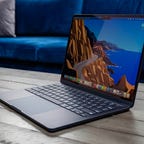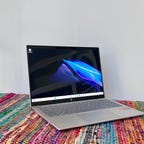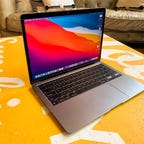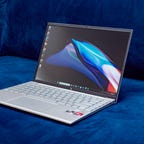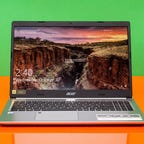Best Laptop of 2024
These are our top picks for MacBooks, Windows machines and Chromebooks -- including the best laptop overall -- all tested and reviewed by CNET editors.
What to consider
Price
Operating System
Size
Screen
Processor
Graphics
Memory
Storage
Our Picks
What is the best laptop overall?
The Apple MacBook Air M3 has captured the top spot on our list of the best laptops of 2024. If you're looking for a do-it-all laptop that doesn't sacrifice portability and battery life for performance, the M3 MacBook Air is it. And it's available in 13- and 15-inch sizes, so you can choose between greater mobility or more workspace. The latest MacBook Air does start at $1,099, though, so we recommend the MacBook Air M1 as a lower-cost alternative to the newest Air model, as it’s still an all-around excellent laptop for $699. For those looking for a Windows alternative to the Air, HP’s Pavilion Aero 13 is an excellent 13-inch, 2.2-pound laptop starting at $880, but frequently available for less than $500 and, in our tests, punches above that price in performance.
The major PC-makers all have new or updated models for 2024 rolling out now. (These are the most anticipated laptops we can't wait to get our hands on.) We've already reviewed several, including our picks for the best two-in-one, the 2024 HP Spectre x360 14, and the best creator laptop right now, the 2024 Asus ROG Zephyrus 14.
At CNET, we test all kinds of laptops -- from budget models for everyday tasks to high-performance laptops for gaming and content creation and everything in between. Each member of our team has decades of experience testing and reviewing laptops. We conduct performance testing under controlled conditions in the CNET Labs and extensive hands-on use. This helps us find not only the best laptop overall but also the best laptop for your needs and in your price range.
Read more: How We Test Computers
Best laptops of 2024
For Apple's latest MacBook Air, little has changed from its predecessor beyond a move from Apple's M2 silicon to M3 chips. The performance differences are overall modest, but graphics performance does get a notable bump. The biggest feature additions are faster Wi-Fi 6E support and the capability to run dual external displays, albeit at the cost of having the Air's lid closed. Still, since Apple gave the M2 MacBook Air (our previous best overall laptop pick) the full update treatment, the fact the M3 version is nearly the same except for faster performance doesn't bother us in the slightest -- it's just that much better. And if you're still rocking an Intel-based Air or an M1 Air, the M3 MacBook Air is a worthy upgrade.
Best Windows laptop
HP Pavilion Plus 14 (2023)
There are a lot of Windows laptops. A lot. Which makes narrowing it down to just one more than a little tricky. However, the HP Pavilion Plus is exemplary because it can meet the needs of a lot of people while still being affordable. It’s available in 14- and 16-inch sizes; we tested the 14-inch, which is small enough for travel but big enough that you won’t feel cramped while working. HP offers AMD and Intel processors, and it can be configured with entry-level discrete graphics too. There are also multiple displays to match your budget, including a beautiful OLED panel.
The starting price is $850, but we recommend getting that OLED screen if you can afford it. It adds about $100 to the package, but it’s worth it. The good news is that HP regularly has deep discounts, so you can get the OLED and a faster processor or more storage and still be around $1,000
Best MacBook for students
Apple MacBook Air M1
Despite the availability of the newer -- and better -- M3 and M2 MacBook Air models, the M1 MacBook Air (one of the first to switch from Intel to Apple silicon) stays around, exclusively from Walmart, and that's a good thing. As Apple's entry-level laptop, it's still a good choice for a MacOS laptop for basic everyday use. It has great performance, long battery life and is thin and light.
Best Windows laptop for students
HP Pavilion Aero 13 (2023)
HP packed a lot of value into the Aero 13: Eye-pleasing magnesium-aluminum chassis, strong processing performance, long battery life, a bright, colorful display and a weight of just 2 pounds (0.94 kilogram). Amazingly, with all that it offers, it doesn't break the bank in terms of price at around $800 well configured, but it's frequently discounted for hundreds less.
Best cheap laptop
Acer Aspire 5
The Acer Aspire 5 continues to be one of the best Windows laptop deals around. Available in 14-, 15.6- and 17.3-inch sizes, I am partial to the 15.6-inch size because it's relatively compact and lightweight but still full-featured. Acer has a wide range of configurations to choose from, starting under $500. This budget laptop also features a USB-C Thunderbolt 4 port, two USB-A 3.2 Gen 1 ports, Ethernet and an HDMI port. Aside from internal components, the Acer Aspire 5 has changed little since we first reviewed it in 2020. However, the components inside continue to improve, continuing to deliver excellent performance and features for its price.
Best Chromebook
HP Dragonfly Pro Chromebook
Most Chromebooks fall below $500, and for general use, they're all most people will need. However, Google's ChromeOS is capable of doing much more than it could more than a decade ago when it first appeared. Consider this HP the MacBook Pro of Chromebooks: beautiful design, excellent display, keyboard and touchpad and enough processing power to take advantage of today's ChromeOS features. And if you're an Android phone user, it's the perfect companion. But it is $1,000, and if that's more Chromebook than you need, check out our full list of the best Chromebooks we've reviewed.
Best Microsoft Surface laptop
Microsoft Surface Pro 8
Although this Microsoft Surface laptop is not the Surface Laptop, the Surface Pro continues to hit all the right notes if you're looking for a do-it-all Windows tablet that doubles as a Windows laptop. Microsoft updated it for the Surface Pro 9, but little has changed beyond a processor upgrade from 11th-gen Intel Core processors to 12th-gen chips, as well as an option for a Microsoft SQ 3 processor with 5G wireless. If you were contemplating a Pro 8, it's still around but now with a lower price, and is our go-to choice. However, here's our review of the Surface Pro 9 so you can see how they measure up.
Best convertible 2-in-1
HP Spectre x360 14 (2024)
We don't make it a practice to recommend laptops that cost nearly $2,000 and rely on integrated graphics. At this price, it's reasonable to expect a dedicated GPU for gaming or content creation. The Spectre x360 14, however, is the rare exception. This two-in-one is one of the first laptops to feature Intel's new Core Ultra CPU that delivers solid performance today and is equipped for the AI workloads of the future. Plus, those graphics integrated to the Core Ultra processor are an improvement on Intel’s previous-generation iGPU.
The all-metal, matte-black chassis is as stunning as the high-res OLED display. And the 9-megapixel webcam is awesome, especially when combined with the AI-assisted Windows Studio Effects and noise reduction features.
With its next-gen Intel Core Ultra CPU, gorgeous OLED display and premium build quality, the Spectre x360 14 is primed for a long and useful life and delivers value, even at its elevated price.
Best laptop for gaming
Alienware m16 R2
Alienware rejiggered its midrange 16-inch m16 to fit more comfortably into its place in the company's gaming laptop universe. That meant lowering its configurations and redesigning it to meet the lower price target buyer. It's now easier on your wallet and to slip into a backpack. While there are certainly more powerful gaming laptops, the m16 meets the needs of a broader audience, so for the moment, it's our top pick.
Best budget gaming laptop
Acer Predator Helios Neo 16 (2023)
Like other gaming laptop makers, Acer has two lines: the budget-friendly Nitro series under the Acer brand and midrange and premium models that carry the Predator label. Oddly enough, it's under the latter you'll find our budget gaming pick: the Helios Neo 16. It is strikingly similar to the Acer Nitro 16 but with slightly better build quality and graphics performance. The only place it really faltered was its speakers, which put out disappointingly flat audio with nonexistent bass.
The Predator Helios Neo 16 currently costs $1,200. That is high for a budget gaming laptop. The trick is to be patient and wait for a sale, which happen regularly, and the price drops to $850.
Best laptop for creators
M3 Pro MacBook Pro (16-inch, late 2023)
Apple's latest update its 16-inch MacBook Pro delivers M3, M3 Pro and M3 Max processors along with a new space black color. The screen is also slightly brighter, moving from a rated 500 nits to 600 nits compared with the previous M2 version. Other than the new color option, the design remains largely unchanged from the previous version, but under the hood, the new M3 Pro chip offers better overall performance and, in particular, big gains in multicore and rendering performance. Battery life is strong too.
Like the previous series, the 16-inch MacBook Pro with the M3 Pro processor starts at $2,499, and the M3 Max model starts at $3,499. It's our Editors' Choice for graphics pros and creators for its excellent combination of design, performance and battery life.
Best Windows laptop for creators
Asus ROG Zephyrus G14 (2024)
Despite being a member of Asus' gaming-focused ROG family of laptops, the G14 has a more creative bent; it's technically considered an Nvidia Studio model and ships with Nvidia's Studio driver rather than the more common Game Ready version (you can swap them if you want). The compact 14-inch laptop has the performance and the display quality you'll need for creative work, a business-quality 1080p webcam and a full selection of ports and connections (although, due to its AMD processor, its USB-C port is USB4 and not Thunderbolt 4).
Other laptops we've tested in 2024
Lenovo ThinkPad X1 Yoga Gen 8: We like Lenovo's premium two-in-one for business, but pricing and configuration options keep us from recommending it for personal use. Unless you need a vPro processor, consider the HP Spectre x360 14 instead.
Lenovo ThinkPad Z13 Gen 2: An outlier among ThinkPads, the Z13 is built like a tank, but it's heavy, and its 13.3-inch display feels cramped compared to the ThinkPad X1 Carbon Gen 11 and HP Dragonfly G4 -- both better picks for most business travelers.
MSI Cyborg 15: MSI's budget gaming laptop isn't bad, especially if you can find it discounted. However, it lags behind the competition in part because of an underpowered graphics chip.
HP Spectre x360 16: While the smaller 14-inch version of this two-in-one earned a spot on our list, the 16-inch size didn't add up for us, with an underpowered GPU and a design that's frankly a bit too big and heavy to use as a tablet except on a desk.
Lenovo LOQ 15: Even for a budget gaming laptop, the LOQ is too blah in design and performance.
Acer Nitro 16: Acer's bargain gaming laptop is a cousin to the Predator Helios Neo 16, our pick for the best budget gaming laptop, and has a similar design and feature set. The Helios offers just a bit more for your money, but if you find the Nitro at a better price, it's certainly worth considering.
Acer Predator Triton 14: It's big and heavy for a little gaming laptop, but it's otherwise an excellent option, especially if you can pick it up at a discount.
Dell Inspiron 14 Plus 7440: Priced at $1,000, it’s a well-rounded, well-built mainstream laptop with a few premium features to keep things interesting.
Lenovo Slim 7i: A good choice if you are looking for a 14-inch OLED laptop but can't stretch to afford the HP Spectre x360 14 and don't need its two-in-one convertibility.
Dell XPS 14 9440: A bit larger than the XPS 13 but with the option of discrete graphics, we like the all-new XPS 14, although the design might be a bit too streamlined for some.
HP Omen Transcend 14: With performance suitable for high-quality 1080p or mid-quality 1440p gaming, along with a striking design, it's a definite option to consider if you're in the market and don't care about a few potential flaws.
How we test laptops
The review process for laptops consists of two parts: performance testing under controlled conditions in the CNET Labs and extensive hands-on use by our reviewers. This includes evaluating a device's aesthetics, ergonomics and features with respect to price. A final review verdict is a combination of both objective and subjective judgments.
We test all laptops with a core set of benchmarks, including Primate Labs Geekbench 5 and 6, Cinebench R23, PCMark 10, a variety of 3DMark benchmarks (whichever can run on the laptop), UL Procyon Photo and Video (where supported), and our own battery life test. If a laptop is intended for gaming, we'll also run benchmarks from Guardians of the Galaxy, The Rift Breaker (CPU and GPU) and Shadow of the Tomb Raider.
For the hands-on, the reviewer uses it for their work during the review period, evaluating how well the design, features (such as the screen, camera and speakers) and manufacturer-supplied software operate as a cohesive whole. We also place importance on how well they work given their cost and where the manufacturer has potentially made upgrades or tradeoffs for its price.
The list of benchmarking software and comparison criteria we use changes over time as the devices we test evolve. You can find a more detailed description of our test methodology on our How We Test Computers page.
Factors to consider
There are a ton of laptops on the market at any given moment, and almost all of those models are available in multiple configurations to match your performance and budget needs. So if you're feeling overwhelmed with options when looking for a new laptop, it's understandable. To help simplify things for you, here are the main things you should consider when you start looking.
Price
The search for a new laptop for most people starts with price. If the statistics chipmaker Intel and PC manufacturers hurl at us are correct, you'll be holding onto your next laptop for at least three years. If you can afford to stretch your budget a little to get better specs, do it. And that stands whether you're spending $500 or more than $1,000. In the past, you could get away with spending less upfront with an eye toward upgrading memory and storage in the future. But laptop makers are increasingly moving away from making components easily upgradable, so again, it's best to get as much laptop as you can afford from the start.
Generally speaking, the more you spend, the better the laptop. That could mean better components for faster performance, a nicer display, sturdier build quality, a smaller or lighter design from higher-end materials or even a more comfortable keyboard. All of these things add to the cost of a laptop. I'd love to say $500 will get you a powerful gaming laptop, for example, but that's not the case. Right now, the sweet spot for a reliable laptop that can handle average work, home office or school tasks is between $700 and $800 and a reasonable model for creative work or gaming upwards of about $1,000. The key is to look for discounts on models in all price ranges so you can get more laptop for less.
Operating system
Choosing an operating system is part personal preference and part budget. For the most part, Microsoft Windows and Apple's MacOS do the same things (except for gaming, where Windows is the winner), but they do them differently. Unless there's an OS-specific application you need, go with the one you feel most comfortable using. And if you're not sure which that is, head to an Apple store or a local electronics store and test them out. Or ask friends or family to let you test theirs for a bit. If you have an iPhone or iPad and like it, chances are you'll like MacOS, too.
But when it comes to price and variety (and, again, PC gaming), Windows laptops win. If you want MacOS, you're getting a MacBook. While Apple's MacBooks regularly top our best lists, the least expensive one is the M1 MacBook Air for $999. It is regularly discounted to $750 or $800, but if you want a cheaper MacBook, you'll have to consider older refurbished ones.
Windows laptops can be found for as little as a couple of hundred dollars and come in all manner of sizes and designs. Granted, we'd be hard-pressed to find a $200 laptop we'd give a full-throated recommendation to, but if you need a laptop for online shopping, email and word processing, they exist.
If you are on a tight budget, consider a Chromebook. ChromeOS is a different experience than Windows; make sure the applications you need have a Chrome, Android or Linux app before making the leap. But if you spend most of your time roaming the web, writing, streaming video or using cloud-gaming services, they're a good fit.
Size
Remember to consider whether having a lighter, thinner laptop or a touchscreen laptop with a good battery life will be important to you in the future. Size is primarily determined by the screen -- hello, laws of physics -- which in turn factors into battery size, laptop thickness, weight and price. And keep in mind other physics-related characteristics, such as an ultrathin laptop isn't necessarily lighter than a thick one, you can't expect a wide array of connections on a small or ultrathin model and so on.
Screen
When it comes to deciding on a screen, there are a myriad number of considerations: how much you need to display (which is surprisingly more about resolution than screen size), what types of content you'll be looking at and whether or not you'll be using it for gaming or creative work.
You really want to optimize pixel density; that is, the number of pixels per inch the screen can display. Though there are other factors that contribute to sharpness, a higher pixel density usually means sharper rendering of text and interface elements. (You can easily calculate the pixel density of any screen at DPI Calculator if you don't feel like doing the math, and you can also find out what math you need to do there.) We recommend a dot pitch of at least 100 pixels per inch (ppi) as a rule of thumb.
Because of the way Windows and MacOS scale for the display, you're frequently better off with a higher resolution than you'd think. You can always make things bigger on a high-resolution screen, but you can never make them smaller -- to fit more content in the view -- on a low-resolution screen. This is why a 4K, 14-inch screen may sound like unnecessary overkill, but may not be if you need to, say, view a wide spreadsheet.
If you need a laptop with relatively accurate color, that displays the most colors possible or that supports HDR, you can't simply trust the specs -- not because manufacturers lie, but because they usually fail to provide the necessary context to understand what the specs they quote mean. You can find a ton of detail about considerations for different types of screen uses in our monitor buying guides for general purpose monitors, creators, gamers and HDR viewing.
Processor
The processor, aka the CPU, is the brains of a laptop. Intel and AMD are the main CPU makers for Windows laptops. Both offer a staggering selection of mobile processors. Making things trickier, both manufacturers have chips designed for different laptop styles, like power-saving chips for ultraportables or faster processors for gaming laptops. Their naming conventions will let you know what type is used. You can head to Intel's or AMD's sites for explanations so you get the performance you want. Generally speaking, though, the faster the processor speed and the more cores it has, the better the performance will be.
Apple makes its own chips for MacBooks, which makes things slightly more straightforward. But, like Intel and AMD, you'll still want to pay attention to the naming conventions to know what kind of performance to expect. Apple uses its M-series chipsets in Macs. The entry-level MacBook Air uses an M1 chip with an eight-core CPU and seven-core GPU. The current models have M2-series silicon that starts with an eight-core CPU and 10-core GPU and goes up to the M2 Max with a 12-core CPU and a 38-core GPU. Again, generally speaking, the more cores it has, the better the performance.
Graphics
The graphics processor (GPU) handles all the work of driving the screen and generating what gets displayed, as well as speeding up a lot of graphics-related (and increasingly, AI-related) operations. For Windows laptops, there are two types of GPUs: integrated (iGPU) or discrete (dGPU). As the names imply, an iGPU is part of the CPU package, while a dGPU is a separate chip with dedicated memory (VRAM) that it communicates with directly, making it faster than sharing memory with the CPU.
Because the iGPU splits space, memory and power with the CPU, it's constrained by the limits of those. It allows for smaller, lighter laptops, but doesn't perform nearly as well as a dGPU. In fact, there are some games and creative software that won't run unless they detect a dGPU or sufficient VRAM. Most productivity software, video streaming, web browsing and other nonspecialized apps will run fine on an iGPU, though.
For more power-hungry graphics needs, like video editing, gaming and streaming, design and so on, you'll need a dGPU; there are only two real companies that make them, Nvidia and AMD, with Intel offering some based on the Xe-branded (or the older UHD Graphics branding) iGPU technology in its CPUs.
Memory
For memory, we highly recommend 16GB of RAM (8GB absolute minimum). RAM is where the operating system stores all the data for currently running applications, and it can fill up fast. After that, it starts swapping between RAM and SSD, which is slower. A lot of sub-$500 laptops have 4GB or 8GB, which in conjunction with a slower disk can make for a frustratingly slow Windows laptop experience. Also, many laptops now have the memory soldered onto the motherboard. Most manufacturers disclose this, but if the RAM type is LPDDR, assume it's soldered and can't be upgraded.
However, some PC makers will solder memory on and also leave an empty internal slot for adding a stick of RAM. You may need to contact the laptop manufacturer or find the laptop's full specs online to confirm. And check the web for user experiences, because the slot may still be hard to get to, it may require nonstandard or hard-to-get memory or other pitfalls.
Storage
You'll still find cheaper hard drives in budget laptops and larger hard drives in gaming laptops, but faster solid-state drives (SSDs) have all but replaced hard drives in laptops. They can make a big difference in performance. But not all SSDs are equally speedy, and cheaper laptops typically have slower drives; if the laptop only has 4GB or 8GB of RAM, it may end up swapping to that drive and the system may slow down quickly while you're working.
Get what you can afford, and if you need to go with a smaller drive, you can always add an external drive or two down the road or use cloud storage to bolster a small internal drive. The one exception is gaming laptops: We don't recommend going with less than a 512GB SSD unless you really like uninstalling games every time you want to play a new game.


